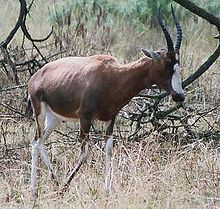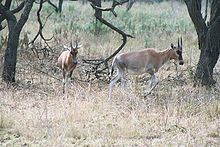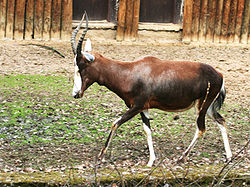- Blesbok
-
Blesbok or Blesbuck 
In Kruger National Park Scientific classification Kingdom: Animalia Phylum: Chordata Class: Mammalia Order: Artiodactyla Family: Bovidae Subfamily: Alcelaphinae Genus: Damaliscus Species: D. pygargus Trinomial name Damaliscus pygargus phillipsi Synonyms Damaliscus dorcas phillipsi
The Blesbok or Blesbuck (Damaliscus pygargus phillipsi) is an antelope with a distinctive white face and forehead. Its white face is the origin of its name, because bles is the Afrikaans word for bald. Although it is a close relative of the Bontebok (Damaliscus pygargus dorcas) and can interbreed with it, creating an animal known as the Bontebles or Baster Blesbok, it does not have the same habitat. The Blesbok is indigenous to South Africa and is found in large numbers in all national parks with open grasslands, from the Transvaal Highveld, through the Free State veld, to as far south as the Eastern Cape. It is a plains species and dislikes wooded areas. It was first discovered in the 17th-century, in numbers so numerous that herds reached from horizon to horizon.
Contents
Physical characteristics
The neck and the top of the back of the Blesbok is brown. Lower down on the flanks and buttocks, the coloring becomes darker. The belly, the inside of the buttocks and the area up to the base of the tail is white. Blesbok can be easily differentiated from other antelopes because they have a distinct white face and forehead. The legs are brown with a white patch behind the top part of the front legs. Lower legs whitish. Both sexes have horns, female horns are slightly more slender. The Blesbok differ from the Bontebok by having less white on the coat and the blaze on the face, which is usually divided, their coats are also a lighter brown than that of the Bontebok. The length of their horns averages at around 38 cm. Male adult Blesbok average around 70 kg, females average lower, at around 61 kg. [1]
- Body Length: 140-160 cm / 4.6-5.3 ft.
- Shoulder Height: 85-100 cm / 2.8-3.3 ft.
- Tail Length: 30-45 cm / 12-18 in.
- Weight: 55-80 kg / 121-176 lb[2].
Habitat
Blesbok can be found in open veld or plains of South Africa. Preferred habitat is open grassland with water.
Reproduction
The Blesbok is a seasonal breeder. Rutting occurs during March to May. Births peak during November and December after a gestation period of about 240 days (8months). Females give birth to single calves.[3]
Status
The Blesbok was hunted nearly to extinction because of its large numbers, but being protected since the late 19th-century its numbers have increased and today is sufficiently numerous so as not to be considered pressured, or endangered. This is largely due to the commercial value that this antelope holds for private land owners, and also that it is one of the few medium-sized antelope that can be contained by normal stock fencing.[citation needed] Blesbok has a stable population, estimated to be around 240,000.[4]. However, 97% of them live outside reserves, and only 3% in national parks. They are also common in zoos.
Predators
Cheetahs, lions, leopards, wild dogs, hyenas, pythons, and jackals and eagles can attack the young calves. The man also hunts him for his coat, his trophy and his meat. To run fast to escape the predators, very timorous and in perpetual alert, this antelope counts on its speed to run away in case of danger. She can run up to a 70 km/h (43 mph) speed to escape her predators. However, although very fast in the running, the white-fronted damalisques are not good jumpers.
Paleontology
Fossil remains of a prehistoric relative named Damaliscus niro were found in deposits in Sterkfontein. With a weight of approximately 120 kilograms it was heavier than the modern Blesbok and it had slightly different horns. Damaliscus niro became extinct at the end of the Pleistocene 12 000 years ago. [5]
References
- ^ Blesbuck
- ^ http://www.ultimateungulate.com/Artiodactyla/Damaliscus_pygargus.html
- ^ Kruger Park: Blesbok
- ^ http://www.iucnredlist.org/apps/redlist/details/30208/0
- ^ Brett Hilton-Barber, Lee R. Berger: Field guide to the Cradle of Humankind: Sterkfontein, Swartkrans, Kromdraai & Environs World Heritage Site. p. 127. Struik, 2004. ISBN 9781770070653
External links
Categories:- Alcelaphinae
- Mammals of South Africa
Wikimedia Foundation. 2010.


